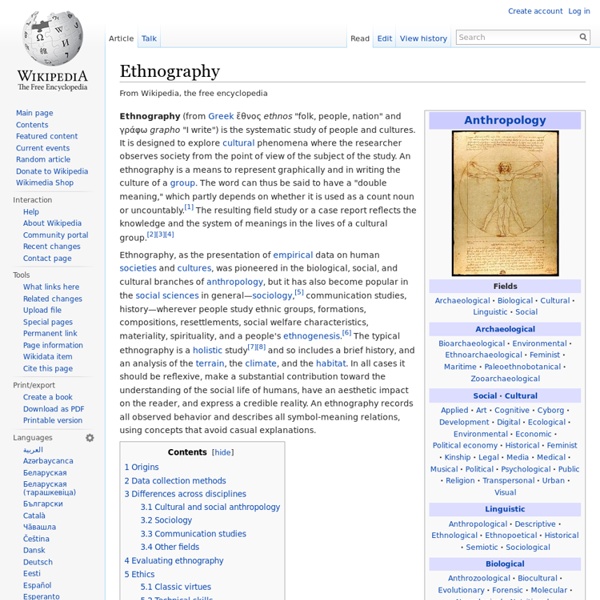Ethnography

Class 03 | Joseph Molinaro
Learning Objectives: To introduce ethnographic research style in design field.To understand the steps in conducting ethnographic research.To learn about the driving and restraining forces for using ethnography in design practice. Discussion Points: What is research? The word research literally means ‘to investigate thoroughly’. What is ethnography? Ethnography is the study of cultures. A brief history of ethnography Ethnography is a social science research method. Definition of Ethnography: Contemporary Perspectives Deconstructing the Definition of Ethnography Qualitative description implies a lack of statistical evidence, but a richer experiential understanding of gathered data. Unique Characteristics of Ethnography How To Do Ethnographic Research? This diagram shows the steps in conducting ethnographic research. what this diagram does not capture is how messy this process really is and how fieldwork , in the sense of collecting data, is one big learning process. The Ethnographic Research Cycle
Czarownice czy znachorki? ''Szeptuchy od czasów pogańskich pełnią rolę lekarzy ludu''
Kim jest szeptucha? - Zgodnie z definicją szeptucha jest tradycyjnym podlaskim uzdrowicielem, który odwołuje się do tradycji tutejszej medycyny ludowej. Ile szeptuch zgodnie z pani szacunkami mamy jeszcze w Polsce? - Nigdy nie stawiałam sobie za cel policzenia wszystkich, dlatego mogę tylko szacować. Poza tym ich liczba regularnie spada, są to w większości osoby bardzo wiekowe - wśród badanych przeze mnie średnia wieku wyniosła 70 lat, a więc co chwilę jedna z szeptuch umiera. Kadr z filmu 'Wyszeptane Uzdrowienie' (fot. Na ile ich działalność jest przejawem duchowości, a na ile konieczności wynikającej z ograniczonego dostępu do lekarzy w tradycyjnych społecznościach wiejskich? - Oba te wymiary - duchowość czy religijność oraz aspekt medyczny - są bardzo ważne. Czyli szeptuchy de facto nie zajmowały się ziołolecznictwem? (fot. Jak w takim razie wygląda praktyka szeptuch? Jakie syndromy czy problemy leczą szeptuchy? (fot. - Tak, to pomaga nam radzić sobie z problemem, bo go materializuje.
Related:
Related:




by raviii Oct 1
Ethnography - is the study of human behaviour and relations within a cultural context. The approach has become subject to debate, partly because of our contemporary awareness that simplistic notions of culture (such as those which satisfied the early anthropologists working in 'foreign' settings) can be misleading- indeed, the very notion of 'culture' is increasingly recognised to be problematic.
Found in: Davies, M. (2007) Doing a Successful Research Project: Using Qualitative or Quantitative Methods. Basingstoke, Hampshire, England, United Kingdom: Palgrave Macmillan. ISBN: 9781403993793. by raviii Jul 31
Ethnography - A qualitative research methodology used to observe people in their natural and uncontrolled social and cultural settings.
Found in: Glossary of Key Terms: by raviii Jul 31
Ethnography: a qualitative research methodology, which places great emphasis on trying to reveal and understand the way respondents look at the world. It is often associated with the use of participant observation.
Found in: 2012 - (Oliver) Succeeding With Your Literature Review by raviii Apr 10
it's a way of getting involved with the people who are using the knowledge by raviii Mar 1
revealing how people describe and structure their world. it uses observation, and in depth interviews by raviii Mar 1
emphasising the everyday experience of individuals by raviii Mar 1
Ethnographic techniques were initially developed in sociology by raviii Mar 1